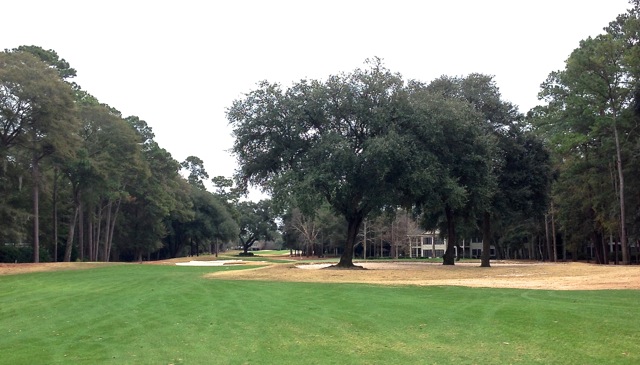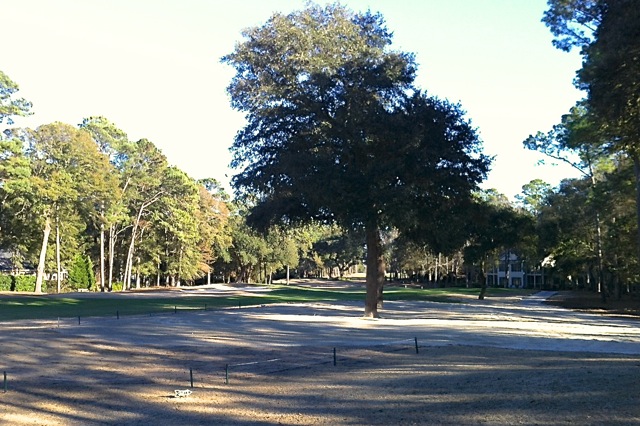In recent years, hundreds of golf clubs across the nation have felled thousands of trees mostly in the name of better air circulation and turf growth, but occasionally for aesthetics and golf course playability. At my home course of Pawleys Plantation, south of Myrtle Beach, you can imagine the handwringing when National Golf Management, which bought the course a couple of years ago, decided to eliminate two impressive live oaks just 80 yards in front of the par 5 11th green. Count me as one of those who hated the idea on paper…and one who was converted when I played the hole a couple of days after the work was done in mid January.
Pawleys Plantation is a challenging layout that Jack Nicklaus completed in 1988, a time when his designs substantially favored those players who hit high, fading shots. From the white tees at just over 6,100 yards, the course rating is 72.0 and the slope a robust 139. Virtually every hole has some element that can easily ruin a round, the par 5s included.
Immediately, at #1, a par five of modest length that fades to the right off the tee and continues in that direction down a fairway protected on the right side by an almost 200-yard-long waste bunker, the Golden Bear’s predisposition is clear...and it only becomes clearer the rest of the round. Although the par 5 4th hole favors a draw off the tee, the opening to the narrow green is along the far left edge, a yawning bunker protecting 90% of the putting surface on the right. A cut-shot short iron is about the only good option for the third shot there. Later in the round, at #14, the shape of the hole mimics #1, with marsh instead of the first hole’s trees, down the entire right side from 250 yards out to the green. The end of the marsh and a fairly deep bunker protect the right side of the green. The player who can move the ball left to right has a decided advantage on the 14th.
 The par 11th at Pawleys Plantation, before two trees were removed from the waste bunker 80 yards in front of the green. For the "after" photo, please click "Read More" below.
The par 11th at Pawleys Plantation, before two trees were removed from the waste bunker 80 yards in front of the green. For the "after" photo, please click "Read More" below.
The other par 5, the 11th, is long and, in the estimation of Pawleys members, probably the most difficult of them all; or at least that’s the way it was before the modern-day Paul Bunyans stepped in. The three back tees sit on one side of a large pond that comes into play on the adjacent par 4 10th but is of trifling consequence for the drive on #11, a carry of only about 100 yards to a fairly generous landing area; actually a slight draw is the favored shot off the tee. Once in the fairway, the second shot is a layup for all, but until the redesign of the hole, as much about placement as it was about length. That was because a large waste bunker with three imposing live oak trees covered virtually the entire redan-shaped green (a redan being a thin-shaped green that runs from front right to rear left and away from the player). If you pushed or faded your shot down the right side of the fairway, the best you could hope for was to be far enough back that a well-struck 5-wood might clear the trees’ dense canopy. (But who wants a 5-wood third shot on any hole?) If you were inside, say, 150 yards, the choice was a lofted iron that was unlikely to carry far enough to make the green, and certainly not if the pin was at the rear of the 100-foot long surface. You could try to punch a low 140-yard 3-iron under the oak tree limbs, but the chances for success were low; more likely was making contact with the live oaks’ lower branches or skittering your shot well off the back of the green, leaving a lob wedge shot back onto the surface that would test Phil Mickelson.
 After the fall, the remaining tree on the 11th at Pawleys Plantation still makes it mandatory for the layup shot to be on the left side of the fairway, just not as far left as before the cut.
After the fall, the remaining tree on the 11th at Pawleys Plantation still makes it mandatory for the layup shot to be on the left side of the fairway, just not as far left as before the cut.
The best play on the second shot was to bomb a layup that hugged the left side of the fairway, avoiding trees and out of bounds farther left, far enough down the fairway to be even with the live oaks and their surrounding waste bunker just to the right, and leaving an open shot to the green –- open, but not easy given the bunker that protects almost all of the green from that angle, save for the very front, where a red flag provides the only unimpeded line to the pin on the third-shot approach. It is a brutally challenging par five that, nine times out of 10 for a 10-handicap player playing from the white tees (542 yards), will yield par only with a one-putt. I know.
The recent demise of the two live oaks fronting the green has made it only slightly easier to position the layup shot. Until they were removed, the upper portion of the trees merged into one large and dense canopy. With the removal of the biggest tree on the left and a smaller one on the right, it appears that the remaining tree actually had provided most of that canopy. There is a bit more room today to maneuver a fairway wood layup down the left center for a clear view of the green, but not much. Any player who leaves his second shot on the right half of the fairway will still need to contend with the dense foliage, although that punched three-iron shot under the limbs is now a little easier to maneuver (actually, a five-iron might work). But to add a little compensating challenge, National Golf Management, apparently with the blessing of Nicklaus and his design group, expanded the waste bunker surrounding the surviving tree so that the sand is now slightly more reachable for bigger hitters on their second shots.
A couple of big live oak trees died to make # 11 at Pawleys Plantation slightly fairer, but the hole still remains the toughest of the four tough par 5s on the course.



